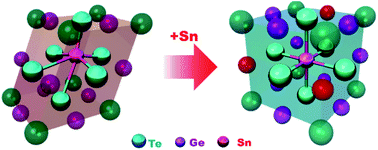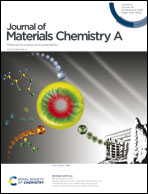Tailoring the phase transition temperature to achieve high-performance cubic GeTe-based thermoelectrics†
Abstract
GeTe is highly sought-after due to its versatility as a high-performance thermoelectric material and phase change material, as well as a ferroelectric Rashba semiconductor. Compared to most thermoelectric materials, it has an additional degree of freedom of rhombohedral–cubic phase transition at 673 K. At this temperature, the lattice thermal conductivity approaches a theoretical minimum due to ferroelectric instability while the high-energy Σ and low-energy L bands converge to give outstanding electronic properties. Therefore, modulation of the phase transition temperature allows simultaneous and synergistic tuning of the electronic and thermal transport properties to achieve high zT. In this work, Sn alloying together with Bi,Sb doping is used to suppress the phase transition to achieve a pure cubic structure with a lattice thermal conductivity of around 0.4 W m−1 K−1 and peak zT of 1.7 at 723 K with an average zT of 1.23 between 400 and 800 K. Furthermore, the Vickers hardness of 270 and Young's modulus of 63.5 GPa in Ge0.4Sn0.4Bi0.02Sb0.12Te are by far the highest amongst binary chalcogenides. More importantly, the high quality factor achieved in this work gives ample room for further zT improvements. The fundamental insights drawn from this work provide a pathway towards engineering GeTe-based alloys to achieve high zT at any temperature of interest.



 Please wait while we load your content...
Please wait while we load your content...